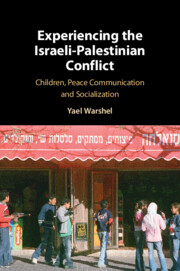Book contents
- Experiencing the Israeli-Palestinian Conflict
- Experiencing the Israeli-Palestinian Conflict
- Copyright page
- Dedication
- Contents
- Figures
- Tables
- Acknowledgments
- Note on the Text
- Abbreviations
- Introduction
- Part I The Encoding and Production of Israeli and Palestinian Sesame Street
- Part II Audience Reception of Israeli and Palestinian Sesame Street
- Part III Situating the Reception of Israeli and Palestinian Sesame Street in Mundane, Intractable Conflict Zone Practices
- Introduction to Part III: Context Analyses and Conflict Zone Methodologies
- 7 Pursuing Justice
- 8 Pursuing Security
- 9 Pursuing Equality
- Part IV Conclusions and Recommendations to Improve Peace Communication Research, (Evidence-Based) Practice and Conflict Intractability Interpretation
- Book part
- References
- Index
- Plate Section (PDF Only)
7 - Pursuing Justice
Palestinian Children’s Schematic Interpretations of the Israeli Army
from Part III - Situating the Reception of Israeli and Palestinian Sesame Street in Mundane, Intractable Conflict Zone Practices
Published online by Cambridge University Press: 08 July 2021
- Experiencing the Israeli-Palestinian Conflict
- Experiencing the Israeli-Palestinian Conflict
- Copyright page
- Dedication
- Contents
- Figures
- Tables
- Acknowledgments
- Note on the Text
- Abbreviations
- Introduction
- Part I The Encoding and Production of Israeli and Palestinian Sesame Street
- Part II Audience Reception of Israeli and Palestinian Sesame Street
- Part III Situating the Reception of Israeli and Palestinian Sesame Street in Mundane, Intractable Conflict Zone Practices
- Introduction to Part III: Context Analyses and Conflict Zone Methodologies
- 7 Pursuing Justice
- 8 Pursuing Security
- 9 Pursuing Equality
- Part IV Conclusions and Recommendations to Improve Peace Communication Research, (Evidence-Based) Practice and Conflict Intractability Interpretation
- Book part
- References
- Index
- Plate Section (PDF Only)
Summary
Chapter 7 is one of three to describe controlled multi-sited ethnographies the author conducted to reverse-path trace the noise that obfuscated the Sesame Street interventions’ effects and impacts. The ethnographies link the children to their specific communities, looking at how glocalization of interstate systemic forces socialized them and how their everyday lives were reshaped by their respective conflict zones, altering their readings of the text—key to understanding their Palestinian, Jewish Israeli, and Arab/Palestinian Israeli cultures-in-the-making. They also shed light on the children’s dialogical critical intra- and cross-cultural mundane conflict zone experiences and perspectives. A detailed layout describes the lives of the Palestinian audience members, residents of the stateless nation village of East Barta’a—how they are perceived by Jewish Israelis seeking security, Arab/Palestinian Israelis seeking equality, and as they see themselves, seeking justice, as an island cut off from the rest of Palestine/the PA by a “wall” and gate to the east and Israel proper to the west. At age 5, they had already become acculturated to their ethnopolitical grouping’s interpretation of conflict zones structures. They symbolically transferred the meaning of “Jew” into an “army of infidels,” preventing them from achieving independence, “correcting” the imbalance they perceived that could not accommodate their interpersonal contact with Israeli soldiers, with Sesame Street’s encoding of civilian and good-natured “Jews.” They normalized the conflict, adopting protest play patterns and explained that the only resolution is “converting Jews to Islam,” eliminating the other party to “the conflict.”
Keywords
- Type
- Chapter
- Information
- Experiencing the Israeli-Palestinian ConflictChildren, Peace Communication and Socialization, pp. 227 - 264Publisher: Cambridge University PressPrint publication year: 2021

